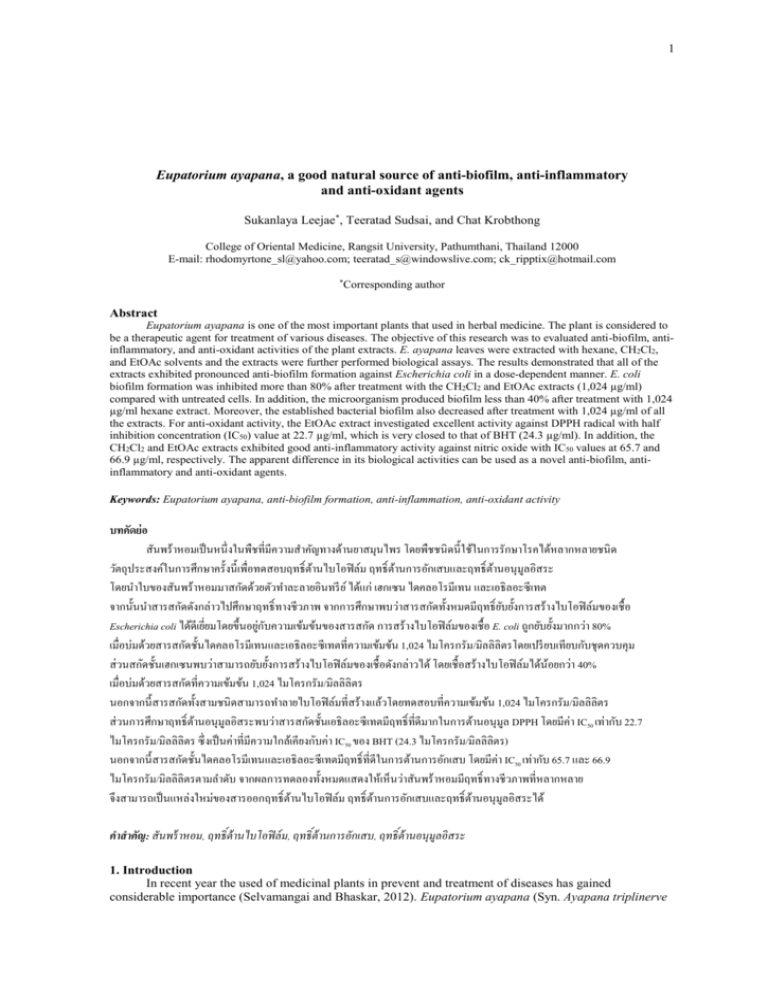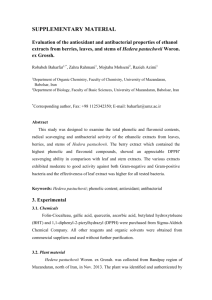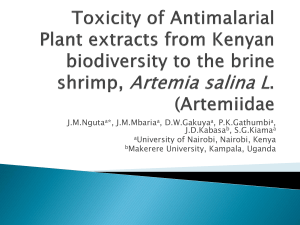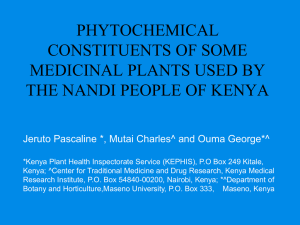Eupatorium ayapana: Anti-biofilm, Anti-inflammatory, Antioxidant
advertisement

1 Eupatorium ayapana, a good natural source of anti-biofilm, anti-inflammatory and anti-oxidant agents Sukanlaya Leejae*, Teeratad Sudsai, and Chat Krobthong College of Oriental Medicine, Rangsit University, Pathumthani, Thailand 12000 E-mail: rhodomyrtone_sl@yahoo.com; teeratad_s@windowslive.com; ck_ripptix@hotmail.com *Corresponding author Abstract Eupatorium ayapana is one of the most important plants that used in herbal medicine. The plant is considered to be a therapeutic agent for treatment of various diseases. The objective of this research was to evaluated anti-biofilm, antiinflammatory, and anti-oxidant activities of the plant extracts. E. ayapana leaves were extracted with hexane, CH2Cl2, and EtOAc solvents and the extracts were further performed biological assays. The results demonstrated that all of the extracts exhibited pronounced anti-biofilm formation against Escherichia coli in a dose-dependent manner. E. coli biofilm formation was inhibited more than 80% after treatment with the CH2Cl2 and EtOAc extracts (1,024 µg/ml) compared with untreated cells. In addition, the microorganism produced biofilm less than 40% after treatment with 1,024 µg/ml hexane extract. Moreover, the established bacterial biofilm also decreased after treatment with 1,024 µg/ml of all the extracts. For anti-oxidant activity, the EtOAc extract investigated excellent activity against DPPH radical with half inhibition concentration (IC50) value at 22.7 µg/ml, which is very closed to that of BHT (24.3 µg/ml). In addition, the CH2Cl2 and EtOAc extracts exhibited good anti-inflammatory activity against nitric oxide with IC50 values at 65.7 and 66.9 µg/ml, respectively. The apparent difference in its biological activities can be used as a novel anti-biofilm, antiinflammatory and anti-oxidant agents. Keywords: Eupatorium ayapana, anti-biofilm formation, anti-inflammation, anti-oxidant activity บทคัดย่อ สันพร้าหอมเป็ นหนึ่งในพืชที่มีความสาคัญทางด้านยาสมุนไพร โดยพืชชนิ ดนี้ ใช้ในการรักษาโรคได้หลากหลายชนิด วัตถุประสงค์ในการศึกษาครั้งนี้ เพื่อทดสอบฤทธิ์ตา้ นไบโอฟิ ล์ม ฤทธิ์ตา้ นการอักเสบและฤทธิ์ตา้ นอนุมูลอิสระ โดยนาใบของสันพร้าหอมมาสกัดด้วยตัวทาละลายอินทรี ย ์ ได้แก่ เฮกเซน ไดคลอโรมีเทน และเอธิลอะซีเทต จากนั้นนาสารสกัดดังกล่าวไปศึกษาฤทธิ์ทางชี วภาพ จากการศึกษาพบว่าสารสกัดทั้งหมดมีฤทธิ์ ยบั ยั้งการสร้างไบโอฟิ ล์มของเชื้ อ Escherichia coli ได้ดีเยีย่ มโดยขึ้นอยูก่ บั ความเข้มข้นของสารสกัด การสร้ างไบโอฟิ ล์มของเชื้ อ E. coli ถูกยับยั้งมากกว่า 80% เมื่อบ่มด้วยสารสกัดชั้นไดคลอโรมีเทนและเอธิลอะซีเทตที่ความเข้มข้น 1,024 ไมโครกรัม/มิลลิลิตรโดยเปรี ยบเทียบกับชุดควบคุม ส่วนสกัดชั้นเฮกเซนพบว่าสามารถยับยั้งการสร้างไบโอฟิ ล์มของเชื้ อดังกล่าวได้ โดยเชื้ อสร้างไบโอฟิ ล์มได้น้อยกว่า 40% เมื่อบ่มด้วยสารสกัดที่ความเข้มข้น 1,024 ไมโครกรัม/มิลลิลิตร นอกจากนี้ สารสกัดทั้งสามชนิ ดสามารถทาลายไบโอฟิ ล์มที่สร้างแล้วโดยทดสอบที่ความเข้มข้น 1,024 ไมโครกรัม/มิลลิลิตร ส่วนการศึกษาฤทธิ์ตา้ นอนุมูลอิสระพบว่าสารสกัดชั้นเอธิ ลอะซี เทตมีฤทธิ์ที่ดีมากในการต้านอนุมูล DPPH โดยมีค่า IC50 เท่ากับ 22.7 ไมโครกรัม/มิลลิลิตร ซึ่งเป็ นค่าที่มีความใกล้เคียงกับค่า IC50 ของ BHT (24.3 ไมโครกรัม/มิลลิลิตร) นอกจากนี้ สารสกัดชั้นไดคลอโรมีเทนและเอธิ ลอะซี เทตมีฤทธิ์ที่ดีในการต้านการอักเสบ โดยมีค่า IC50 เท่ากับ 65.7 และ 66.9 ไมโครกรัม/มิลลิลิตรตามลาดับ จากผลการทดลองทั้งหมดแสดงให้เห็นว่าสันพร้าหอมมีฤทธิ์ทางชี วภาพที่หลากหลาย จึงสามารถเป็ นแหล่งใหม่ของสารออกฤทธิ์ตา้ นไบโอฟิ ล์ม ฤทธิ์ตา้ นการอักเสบและฤทธิ์ ตา้ นอนุมูลอิสระได้ คำสำคัญ: สันพร้ าหอม, ฤทธิ์ ต้านไบโอฟิ ล์ ม, ฤทธิ์ ต้านการอักเสบ, ฤทธิ์ ต้านอนุมูลอิ สระ 1. Introduction In recent year the used of medicinal plants in prevent and treatment of diseases has gained considerable importance (Selvamangai and Bhaskar, 2012). Eupatorium ayapana (Syn. Ayapana triplinerve 2 Vahl. and Eupatorium triplinerve Vahl.) belongs to Asteraceae family and is one of the most important plants used in herbal medicine. It is an ornamental erect perennial herb with aromatic leaves and reddish brown stems. The medicinal plant is native to South America and can be found in other tropical countries such as Hawaii, India, and Vietnam (Gauvin-Bialecki and Marodon, 2009). According to its ethnopharmalogical use, the plant is widely used as folk medicine for immediate arrest of bleeding of blood from wound in India (Rajasekaran et al., 2010). In Indonesia, the leaves of E. ayapana are tropical used for skin care in combination with other herbs (Arung et al., 2012). Moreover, the plant extracts have been reported to exhibit anti-venom (Maiti and Mishra, 2000), anti-inflammatory (Parimala et al., 2012), antimicrobial (Begum et al., 2010; Narayanan et al., 2011), anti-oxidant (Bepari et al., 2007; Bos et al., 2007; Melo et al., 2013), hepatoprotective (Bos et al., 2007), antinociceptive (Melo et al., 2013; Parimala et al., 2012), and haemostatic (Rajasekaran et al., 2010) properties. However, anti-biofilm formation of the medicinal plant has not been evaluated. Biofilms are communities of microorganisms attached to a surface. All biofilms, regardless of their location, share several common features. These include the synthesis of an extracellular polymeric matrix that holds the bacterial cells together (Kaplan, 2010). Biofilms are more resistant to antimicrobial agents compared to free-living or planktonic cells (Mah and O’Toole, 2001). In addition, implanted medical devices including intravenous catheters, artificial joints and, cardiac pacemakers are prime targets for bacterial biofilm formation (Donlan and Costerton, 2002; Parsek and Singh, 2003). The inherent protective nature of the biofilm colony makes most biofilm-associated infections difficult or impossible to eradicate (Kaplan, 2010). Consequently, effective agents are necessary to control biofilm-producing bacteria. Therefore, the present study has been designed to investigate E. ayapana leaf extracts for its antibiofilm formation and biological activities. 2. Materials and methods 2.1 Preparation of E. ayapana extracts The air-dried ground leaves of E. ayapana (50 g) were extracted with ethanol (3 x 400 ml) in a Soxhlet extractor. The ethanolic extract (10.5653 g) was successively partitioned with hexane, CH 2Cl2, and EtOAc and evaporated to obtain hexane-, CH2Cl2- and EtOAc-extracts with yield 2.1240, 0.9761, and 0.5225 g, respectively. All of the extracts were kept at 4C for future study on antimicrobial, anti-inflammatory, and anti-oxidant activities. 2.2 Bacterial strains and growth conditions Bacterial strains including Staphylococcus aureus ATCC 29213, S. epidermidis ATCC 35984, Escherichia coli ATCC 25922, and Pseudomonas aeruginosa ATCC 10145 were used in this study. All bacterial strains were cultured on Mueller-Hinton agar (MHA) and incubated at 37ºC for overnight. The pathogens were suspended in Mueller-Hinton broth (MHB) and incubated at 37C for 3-5 h, and turbidity was adjusted to McFarland standard number 0.5 with 0.85% NaCl solution to achieve a concentration of approximately 1.5 x 108 colony forming unit (CFU)/ml. 2.3 Determination of minimum inhibitory concentration (MIC) and minimum bactericidal concentration (MBC) A modified broth microdilution method outlined by Clinical and Laboratory Standards Institute (CLSI) was performed (CLSI, 2011). The plant extracts were dissolved in 10% dimethyl sulphoxide (DMSO) and diluted two-fold to give final concentrations ranged from 0.5-1,024 µg/ml. One hundred microliters of the bacterial suspensions, containing approximately 10 6 CFU/ml of the microorganism, was inoculated in 80 µl of MHB supplemented with 20 µl of the extracts. The microtiter plates were incubated at 37C for 16-18 h. Minimum inhibitory concentration was recorded as the lowest concentration of the extracts that was not permitted for any turbidity of the tested organism. Aliquots from the broth with no growth were spread onto fresh MHA plates using a sterile loop and incubated at 37°C for overnight. The MBC was the lowest concentration that produced a complete kill of the microorganism. Vancomycin and gentamicin were included as positive controls. 2.4 Effect of E. ayapana extracts on biofilm formation 3 An experiment was performed according to the protocol of Karaolis et al. (2005) with slight modifications. Briefly, E. ayapana extracts were dissolved in 10% DMSO and diluted two-fold dilution in 96-well plate to give final concentrations ranged from 64-1,024 µg/ml. One hundred microliters of E. coli suspension, containing approximately 106 CFU/ml of the microorganism in tryptic soy broth (TSB) supplemented with 0.25% glucose, was transferred to the 96-well plate containing 20 µl E. ayapana extracts and 80 µl TSB supplemented with 0.25% glucose. The microtiter plates were incubated at 37C for 24 h. After incubation, the wells were washed twice with PBS to remove free-living cells, air-dried and stained with 200 µl 0.1% crystal violet solution for 30 min. The plates were washed twice with distill water, airdried, and dissolved with 200 µl DMSO. Biofilm formation was measured at OD 570 nm using a microplate reader. 1% DMSO was included as negative control. The relative percentage of biofilm formation was defined as: (mean OD 570 nm of treated well/mean OD 570 nm of control well) x100. 2.5 Effect of E. ayapana extracts on established biofilms Established biofilms of E. coli were grown as described by Kuzma et al. (2007). Two hundred microliters of E. coli suspension, containing approximately 106 CFU/ml of the microorganism in TSB supplemented with 0.25% glucose, was transferred to the 96-well plate. The microtiter plates were incubated at 37C for 24 h. After incubation, the medium was removed and the wells were rinsed twice with PBS. TSB supplemented with 0.25% glucose (180 µl) and 20 µl of E. ayapana extracts at different concentrations (641,024 µg/ml) were added. After incubation, the established biofilm was stained and measured as describe above. 2.6 Inhibitory effects on LPS-induced nitric oxide (NO) production from RAW264.7 cells RAW264.7 cells were seeded into 96-well plates with 1 x 105 cells/well and allowed to adhere for 1 h at 37ºC in a humidified atmosphere containing 5% CO2. The medium was replaced with a fresh medium containing 100 ng/ml of LPS (from E. coli, 055:B5) together with the test samples at various concentrations (3-100 µg/ml) and incubated for 24 h. NO synthase inhibitor (L-NA), NF-B inhibitor (CAPE) and nonsteroidal anti-inflammatory drugs, NSAIDs (indomethacin) were used as positive controls. The stock solution of each test sample was dissolved in 1% DMSO, and the solution was added to the medium RPMI. NO production by RAW264.7 cells was determined by measuring the accumulation of nitrite in the culture supernatant using the Griess reagent as previously described (Tewtrakul et al., 2009). After 24 h of incubation, cells generated NO in the medium, the supernatant (100 µl) were collected and reacted with Griess reagent (100 µl). NO production was measured spectrophotometrically at 570 nm using a microplate reader. The percent inhibition was calculated based on the following equation and IC 50 values were determined graphically (n = 4): Inhibition (%) = [(A - B) / (A - C)] × 100 A-C: NO2- concentration (µM) [A: LPS (+), sample (-); B: LPS (+), sample (+); C: LPS (-), sample (-)]. 2.7 Viability assay of RAW264.7 macrophage cells Viability of RAW264.7 cells was assayed using MTT colorimetric method after 24 h incubation with various concentrations of test samples. This method requires active mitochondria of living cells to reduce MTT, a pale yellow substrate to yield a dark blue formazan product. Briefly, MTT solution (10 µl, 5 mg/ml) was added to the wells and further incubated for 4 h at 37ºC in a humidified atmosphere containing 5% CO2. The medium was removed, the formazan products made due to dye reduction by viable cells were dissolved using DMSO and the optical density was measured with microplate reader at a wavelength of 570 nm. The test samples were considered to be cytotoxic when the optical density of the sample-treated group was less than 80% of that in the control group. 2.8 2, 2-Diphenyl-1-picrylhydrazyl radical (DPPH) scavenging assay The methodology in order to assess the DPPH free radical scavenging capacity described by Jitsanong et al. (2011) was used in this study with slight modifications. The stock solution (10 µg/ml) of the sample was prepared in DMSO and diluted to concentrations ranging from 1-200 µg/ml with absolute ethanol. The reaction mixture contained 100 µl of samples at various concentrations and 100 µl of 0.1 mM DPPH in absolute ethanol. Butylated hydroxytoluene (BHT) and quercetin were used as positive controls. 4 The DPPH solution in the absence of sample was used as a control and the absolute ethanol was used as a blank. The bleaching was measured at 517 nm using a microplate reader after incubation for 30 min in the dark condition. The percentage of scavenging activity of the sample against DPPH radical was calculated according to the following equation and IC50 values were determined graphically (n = 4): % Inhibition = [(A control - A sample) / A control] 100 A control = Absorbance of control - Absorbance of control blank A sample = Absorbance of sample - Absorbance of sample blank 3. Results and discussion 3.1 Antibacterial activity and anti-biofilm formation E. ayapana leaves were collected from Ayuthaya province, Thailand in December 2013 and extracted with ethanol using Soxhlet extractor. The ethanolic extract was further partitioned with hexane, CH 2Cl2, and EtOAc solvents. The results demonstrated that the heighted yield was observed in hexane fraction (2.12 g). Facknath and Lalljee (2008) reported that the heighted % yield of the fresh young leaves was obtained from hexane fraction (3%). In contrast, the hexane fraction exhibited the lowest amounts of alkaloids, sterols, terpenes, phenols, tannins, and flavonoids compared with petroleum ether and CHCl3-methanol fractions (Facknath and Lalljee, 2008). Moreover, Parimala et al. (2012) demonstrated that the presence of sterols, carbohydrates, tannins, phenols, glycosides, and alkaloids was detected in the petroleum ether extract. In vitro antibacterial activity of E. ayapana extracts against human pathogens was evaluated using broth microdilution method. The activities of the extracts against human pathogens are indicated in Table 1. All of the extracts investigated weak antibacterial properties against the tested microorganisms. The MIC and MBC values of the extracts against Gram-positive and Gram-negative pathogens ranged from 512->1,024 µg/ml. The results suggested that all of the extracts showed no antibacterial activity against E. coli (MIC/MBC >1,024 µg/ml). The results correlated with bacterial growth study as demonstrated in Figure 1. E. ayapana extracts elucidated no inhibition effect on bacterial growth after incubation with the extract for 24 h. In 2011, Narayanan et al. (10) reported that E. ayapana methanolic extract showed no activity against multiple antibiotic resistant uropathogens. Begum and co-workers (2010-7) showed that essential oil from E. ayapana aerial parts extracts exhibited weak antibacterial and antifungal activities against 10 bacterial strains and six phytopathogenic fungi with MIC values ranged from 6,000-21,000 ppm. Rahman and Junaid (200812) reported that CHCl3 extract of the leaves showed the largest zone of inhibition (22 mm in diameter with 1,000 µg/disc extract) against Vibrio spp. Moreover, the extract demonstrated moderate antibacterial activity against the pathogen with MIC value at 125 µg/ml (Rahman and Junaid, 2008). Table 1. Minimum inhibitory concentration (MIC) and minimum bactericidal concentration (MBC) of Eupatorium ayapana extracts against Gram-positive and Gram-negative pathogenic bacteria MIC/MBC (µg/ml) S. aureus S. epidermidis ATCC E. coli P. aeruginosa Fraction ATCC 25923 35984 ATCC 25922 ATCC 10145 Hexane >1,024/>1,024 >1,024/>1,024 >1,024/>1,024 >1,024/>1,024 CH2Cl2 EtOAc Vancomycin Gentamicin 512/>1,024 1,024/>1,024 0.5/0.5 - 1,024/>1,024 1,024/>1,024 0.5/1 - >1,024/>1,024 >1,024/>1,024 0.5/1 1,024/>1,024 1,024/>1,024 1/4 5 140 % Bacterial growth 120 100 80 60 40 20 0 1,024 512 256 128 Concentration (µg/ml) 64 0 Figure 1. Bacterial growth of Escherichia coli ATCC 25922 after treatment with various concentrations of hexane (black bars), CH2Cl2 (open bars) and EtOAc (shaded bars) extracts of Eupatorium ayapana. 1% DMSO was included as negative control. The present study evaluated that E. ayapana extracts exhibited excellent anti-biofilm formation of E. coli (Figure 2). E. coli biofilm formation was inhibited more than 80% after treatment with the CH2Cl2, and EtOAc extracts (1,024 µg/ml) compare with untreated cells. In addition, the microorganism produced biofilm less than 40% after treatment with 1,024 µg/ml hexane extract. Treatment all of the extracts at 512 and 256 µg/ml was found to be effective in reducing E. coli biofilm formation by approximately 40% and 20%, respectively. However, all of the extracts at concentration 64-256 µg/ml showed slightly effect on biofilm formation. The impact of the extracts on biofilm formation was found to be dose-dependent. For anti-established biofilm, the organism at mid-exponential phase was culture to produced biofilm for 24 h and then exposed with various concentrations of E. ayapana extracts. The results indicated that the addition of E. ayapana extracts (1,024 µg/ml) to the culture also resulted in decreased established bacterial biofilm. However, all of the leaves extracts at concentration 64-512 µg/ml had little effect on the established biofilm of the bacterial strain (Figure 3). More than 70 years after the first report on biofilms (Zobell, 1943), they are still a concern in a broad range of areas especially biomedical fields. Biofilm development can be divided into three distinct stages: attachment of cells to a surface, formation of a multilayered cell cluster surrounded by extracellular polysaccharide matrix, and detachment of cells from the colony into the surrounding medium (Kaplan, 2010). The production of extracellular polysaccharide matrix constitute a protected mode of growth that allows microorganisms to survival in hostile environments and it has become clear that biofilm-grown cells express properties distinct from planktonic cells (Mah and O’Toole, 2001). Therefore, the emergence of resistant bacteria to conventional antimicrobial agents clearly demonstrates that new biofilm control strategies are required (Simoes et al., 2010). 6 120 % Biofilm formation 100 80 60 40 20 0 1,024 512 256 128 Concentration (µg/ml) 64 0 Figure 2. Anti-biofilm formation of Escherichia coli ATCC 25922 after treatment with various concentrations of hexane (black bars), CH2Cl2 (open bars) and EtOAc (shaded bars) extracts of Eupatorium ayapana. 1% DMSO was included as negative control. 120 % Biofilm formation 100 80 60 40 20 0 1,024 512 256 128 Conecentration (µg/ml) 64 0 Figure 3. Anti-established biofilm formation of Escherichia coli ATCC 25922 after treatment with various concentrations of hexane (black bars), CH2Cl2 (open bars) and EtOAc (shaded bars) extracts of Eupatorium ayapana. 1% DMSO was included as negative control. 3.2 In vitro toxicity and anti-inflammation Cytotoxicity test was performed in RAW264.7 cells and the results demonstrated that all of the extracts were non-toxic to the tested cells at concentration 100 µg/ml. Moreover, the CH2Cl2 and EtOAc extracts exhibited moderate anti-inflammatory activity against nitric oxide in RAW264.7 cells with IC 50 values at 65.7 and 66.9 µg/ml, respectively (Table 2). In 2013, Melo et al. evaluated acute oral toxicity of E. 7 ayapana ethanolic extract in mice. The results showed that no death was observed after treatment with 2,000 mg/kg and 5,000 mg/kg of the extract dosage for 14 days. The result was similar to Parimala et al. (2012), who reported that the petroleum ether extract was non-toxic up to a maximum dose of 2,000 mg/kg body weight of mice. Moreover, the extract exhibited antinociceptive and anti-inflammatory activities in vivo. The extract investigated that significant inhibition of acetic acid induced writhing and carrageenan induced hind paw ederma in rats (Parimala et al., 2012). In addition, the ethanolic extract has been reported as mild sedative, anxiolytic, and antidepressive effects on central nerve system (Melo et al., 2013). Table 2. Anti-inflammatory activity of Eupatorium ayapana extracts on inhibition of nitric oxide production in RAW264.7 cells % inhibition at various concentration (µg/ml) IC50 Fraction (µg/ml) 0 1 3 10 30 100 Hexane >100 0.01.7 17.11.3 22.60.7 44.20.5 CH2Cl2 65.7 0.01.7 16.20.9 26.31.0 62.30.4 EtOAc 66.9 0.01.7 17.11.5 26.71.6 61.52.3 L-NA 32.6 0.02.4 20.02.3 35.51.7 90.00.8 CAPE 2.0 0.02.4 35.91.7 62.01.7 74.01.0 84.90.8 104.50.8* Indomethacin 33.8 0.02.4 4.81.5 16.72.0 38.53.0 87.20.3 * Cytotoxic effect was observed. Value represents mean S.E.M. (n=4). 3.3 Anti-oxidant activity For anti-oxidant activity, the EtOAc extract of E. ayapana investigated pronounced activity against DPPH radical with IC50 value at 22.7 µg/ml, which is very closed to that of BHT (24.3 µg/ml). In addition, IC50 values of the CH2Cl2 and hexane against DPPH radical were 83.9 and >200 µg/ml, respectively (Table 3). The results suggested that anti-oxidant agents may obtain from EtOAc fraction. Bepari and co-workers (2013) showed that E. ayapana leaf extracts exhibited enhance anti-oxidant potential in Ehrlich’s ascites carcinoma-bearing Swiss albino mice. Moreover, the aerial part extract decreased Trolox equivalent antioxidant capacity, nitric oxide, and malondialdehyde leves in response to swimming stress induced in rats (Melo et al., 2013). Table 3. Antoxidant activity of Eupatorium ayapana extracts against DPPH radical Fraction Hexane CH2Cl2 EtOAc BHT Quercetin 0.78 1.50.3 19.71.3 1.56 5.90.1 42.22.6 % inhibition at various concentration (µg/ml) 3.13 6.25 12.5 25 50 22.81.3 36.32.1 61.12.4 1.60.8 12.81.3 29.71.7 30.41.8 53.41.7 76.91.4 11.00.9 21.80.1 35.90.7 52.70.1 68.81.4 73.64.7 90.11.0 91.80.2 92.70.1 91.61.3 100 -7.63.2 49.90.7 88.80.4 79.50.4 93.00.1 200 -0.23.1 82.00.8 100.71.0 88.40.5 94.10.4 IC50 (µg/ml) >200 83.9 22.7 24.3 1.8 Value represents mean S.E.M. (n=4). 4. Conclusions The hexane, CH2Cl2, and EtOAc extracts exhibited pronounced anti-biofilm formation against E. coli in a dose-dependent manner. Moreover, the EtOAc fraction demonstrated excellent anti-oxidant activity against DPPH radical. In addition, the CH2Cl2 and EtOAc extracts showed good anti-inflammatory activity without toxic property to RAW264.7 cells. The apparent difference in its biological activities can be used as a novel anti-biofilm, anti-inflammatory, and anti-oxidant agents. 5. Acknowledgements The authors would like to thank Prof. Dr. Supayang Voravuthikunchai, Director of Natural Product Research Center of Excellence, Prince of Songkla University, and Dr. Jongkon Saising, Faculty of Medical Technology, Prince of Songkla University for supporting bacterial cultures. We are thankful to College of Oriental Medicine and Faculty of Pharmacy, Rangsit University for providing the facilities in this study. This work was supported by Research Institute, Rangsit University (grant number 04/2557). 6. References 8 Arung, E. T., Kuspradini, H., Kusuma, I. W., Shimizu, K., & Kondo, R. (2012). Validation of Eupatorium triplinerve Vahl leaves, a skin care herb from East Kalimantan, using a melanin biosynthesis assay. J Acupunct Meridian Stud, 5, 87-92. Begum, J., Bhuiyan, N. I., & Taznin, T. (2010). Chemical composition and antimicrobial activity of essential oil from Eupatorium triplinerve Vahl. aerial parts. Asian J Microbiol Biotech Env Sci, 12, 543-547. Bepari, M., Maity, P., Sinha, B., & Choudhury, S. M. (2007). Eupatorium ayapana leaf extracts enhance anti-oxidant potential in Ehrlich’s ascites carcinoma-bearing Swiss albino mice. Int J Life Phama Res, 3, 1-10. Bos, P., Gupta, M., Mazumder, U. K., Kumar, R. S., Thangavel, S., & Kumar, R. S. (2007). Hepatoprotective and anti-oxiddant effects of Eupatorium ayapana against carbon tetrachloride induced hepatotoxicity in rats. Iranian J. Pharmacol Ther, 6, 27-33. Clinical and Laboratory Standards Institute. (2011). Methods for dilution antimicrobial susceptibility tests for bacteria that grow aerobically; approved standard-eighth Edition. Pennsylvania: Clinical and Laboratory Standards Institute. Donlan, R. M., & Costerton, J. W. (2002). Biofilms: survival mechanisms of clinically relevant microorganisms. Clin Microbiol Rev, 15, 167-193. Facknath, S., & Lalljee, B. (2008). Study of various extracts of Ayapana triplinervis for their potential in controlling three insect pests of horticulture crops. Tropicaltura, 26, 119-124. Gauvin-Bialecki, A., & Marodon, C. (2009). Essential oil of Ayapana triplinerveis from Reunion Island:a good natural source of thymohydroquinone dimethyl ether. Biochem Syst Ecol, 36, 853-858. Jitsanong, T., Khanobdee, D., Piyachaturawat, P., & Wongprasert, K. (2011). Diarylheptanoid 7-(3,4 dihydroxyphenyl)-5-hydroxy-1-phenyl-(1E)-1-heptene from Curcuma comosa Roxb. protects retinal pigment epithelial cells against oxidative stress-induced cell death. Toxicology in Vitro, 25, 167-176. Kaplan, J. B. (2010). Biofilm dispersal: mechanisms, clinical implications, and potential therapeutic uses. J Dent Res, 89, 205-218. Karaolis, D. K., Rashid, M. H., Chythanya, R., Luo, W., Hyodo, M. & Hayakawa, Y. (2005). c-di-GMP (3959-cyclic diguanylic acid) inhibits Staphylococcus aureus cell-cell interactions and biofilm formation. Antimicrob Agents Chemother, 49, 1029-1038. Kuzma, L., Rozalski, M., Walencka, E., Rozalska, B., & Wysokinska, H. (2007). Antimicrobial activity of diterpenoids from hairy roots of Salvia sclarea L.: salvipisone as a potential anti-biofilm agent active against antibiotic resistant staphylococci. Phytomedicine, 14, 31-35. Mah, T. F. C., & O’Toole, G. A. (2001). Mechanisms of biofilm resistance to antimicrobial agents. Trends Microb, 9, 34-39. Maiti, S., & Mishra, T. K. (2000). Anti-venom drugs of Santals, Savars and Mahatos of Midnapore distric of West Bengal, India. Ethnobotany, 12, 77-80. Melo, A. S., Monteiro, M. C., Silva, j. B., Oliverra, F. R., Vieira, J. S. F., Andrade, M. A., Baetas, A. C., Sakai, J. T., Ferreira, F. A., Sousa, P. J. C., & Maia, C, S. F. (2013). Antinociceptive, neurobehavioral and anti-oxidant effects of Eupatorium triplinerve Vahl on rats. J Ethnopharmacol, 147, 293-301. Narayanan, A. S., Raja, S. S. S., Ponmurugan, K., Kandekar, S. C., Natarajaseenivasan, K., Maripandi, A., & Mandeel, Q. A. (2011). Antibacterial activity of selected medicinal olants against multiple antibiotic resistant uropathogens: a study from Kolli Hills, Tamil Nadu, India. Beneficial Microbes, 2, 235-243. Parimala K., Cheriyan, B. V., & Viswanathan, S. (2012). Antinociceptive and anti-inflammatory activity of petroleum ether extract of Eupatorium triplinerve Vahl. Int J Life Phama Res, 2, 12-16. Parsek, M. R., & Singh, P. K. (2003). Bacterial biofilms: an emerging link to disease pathogenesis. Annu Rev Microbiol, 57, 677-701. Rahman, S., & Junaid, M. (2008). Antimicrobial activity of leaf extracts of Eupatorium triplinerve Vehl. against some human pathogenic bacteria and phytopathogenic fungi. Bangladesh J Bot, 37, 89-92. Rajasekaran, A., Kalaivani, M., & Ariharasivakumar, G. (2010). Haemostatic effect of fresh juice and methanolic extract of Eupatorium ayapana leaves in rat model. Inter J Biol Med Res, 1, 85-87. Selvamangai, G., & Bhaskar, A. (2012). GC-MS analysis of phytocomponents in the methanolic extract of Eupatorium triplinerve. Asian Pacific J Tropical Biomed, 2012, 1329-1332. Simoes, M., Simoes, L. C., & Vieira, M. J. (2010). A review of current and emergent biofilm control strategies. LWT-Food Sci Tech, 43, 573-583. 9 Tewtrakul, T., Subhadhirasakul, S., Karalai, C., Ponglimanont, C., & Cheenpracha, S. (2009). Antiinflammatory effects of compounds from Kaempferia parviflora and Boesenbergia pandurata. Food Chem, 115, 534-538. Zobell, C. E. (1943). The effect of solid surfaces upon bacterial activity. J Bacteriol, 46, 39-56.








